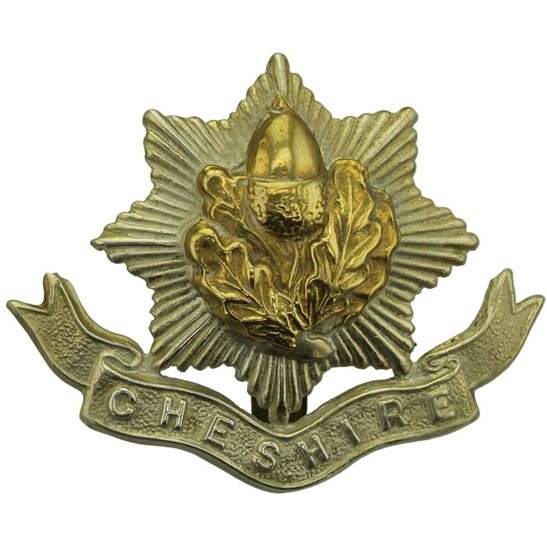Personal Details
Born: 4 November 1895 in Salford Lancashire.
Family: William was sent to live with his aunt in Whitchurch, Shropshire. He married Cicely Slattery in 1922 and together they had 2 children, Patricia Rosemary and James Michael
Civilian Occupation: In 1911 he was a gardener. After the war, he worked for Crown Agents which entailed overseas travel on several occasions. William was taken as a civilian Prisoner of War by the Japanese when Singapore was overrun in 1942 and was interred in Changi prison and Sime Road prison until the surrender of the Japanese army in 1945.
Residence: Bridge Cottage, Grindley Brook, Whitchurch, Shropshire. It is probable that he lived in Singapore between 1922 and 1942. After his death the family settled in Durban, South Africa where his daughter married and his wife and 2 children died.
Died: 11 October 1948, aged 52, from pneumonia in St Stephen’s Hospital, London and was buried in Brompton Cemetery
Military Details
Regiment: Cheshire Regiment
Rank: Lance Corporal
Service Number: 9943
Date of Enlistment: 26 August 1912
Date of Discharge: 19 June 1919
Reason for Discharge: No longer fit for service
Other Information: At 18 he joined the Cheshire Regiment and served throughout the war.
William was awarded the Military Medal & Campaign Medals (1914/15 Star, British War Medal, and Victory Medal).

Until 1993, the Military Medal (MM) was a military decoration awarded to personnel of the British Army and other services, and formerly also to personnel of other Commonwealth countries, below commissioned rank, for bravery in battle on land.
The medal was established on 25 March 1916. It was the other ranks' equivalent to the Military Cross (MC), which was awarded to commissioned officers and, rarely, to warrant officers, although WOs could also be awarded the MM. The MM ranked below the Distinguished Conduct Medal (DCM), which was also awarded to non-commissioned members of the Army.
Click on the tags below to see details of each recipient.

The 1914 Star (also known as 'Pip') was authorised under Special Army Order no. 350 in November 1917 and by an Admiralty Fleet Order in 1918, for award to officers and men of the British and Indian Expeditionary Forces who served in France or Belgium between 5 August and midnight of 22–23 November 1914. The former date is the day after Britain's declaration of war against the Central Powers, and the closing date marks the end of the First Battle of Ypres.
The 1914–15 Star (also known as 'Pip') was instituted in December 1918 and was awarded to officers and men of British and Imperial forces who served against the Central European Powers in any theatre of the Great War between 5 August 1914 and 31 December 1915. The period of eligibility was prior to the introduction of the Military Service Act 1916, which instituted conscription in Britain.
The British War Medal (also known as 'Squeak') was a silver or bronze medal awarded to officers and men of the British and Imperial Forces who either entered a theatre of war or entered service overseas between 5th August 1914 and 11th November 1918 inclusive. This was later extended to services in Russia, Siberia and some other areas in 1919 and 1920. Approximately 6.5 million British War Medals were issued. Approximately 6.4 million of these were the silver versions of this medal. Around 110,000 of a bronze version were issued mainly to Chinese, Maltese and Indian Labour Corps. The front (obv or obverse) of the medal depicts the head of George V. The recipient's service number, rank, name and unit was impressed on the rim.
The Allied Victory Medal (also known as 'Wilfred') was issued by each of the allies. It was decided that each of the allies should each issue their own bronze victory medal with a similar design, similar equivalent wording and identical ribbon. The British medal was designed by W. McMillan. The front depicts a winged classical figure representing victory. Approximately 5.7 million victory medals were issued. Interestingly, eligibility for this medal was more restrictive and not everyone who received the British War Medal ('Squeak') also received the Victory Medal ('Wilfred'). However, in general, all recipients of 'Wilfred' also received 'Squeak' and all recipients of The 1914 Star or The 1914/1915 Star (also known as 'Pip') also received both 'Squeak' and 'Wilfred'. The recipient's service number, rank, name and unit was impressed on the rim.


William was a Japanese Internee at the fall of Singapore 1942. First Changi Jail then Sime Road. Liberated September 1945 and on his return to England, died 1948 at St. Stephens Hospital London.
Many thanks for your additional information. We have undertaken some further research and identified William and Cicely had 2 children, both probably born in Singapore. We have updated our Great War website with this additional information. Thanks again
Terry